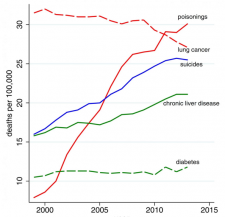A surprising and disconcerting new study published in the Proceedings of the National Academy of Sciences (PNAS) reveals a significant rise in the death rate of white middle-aged Americans since 1999. The apparent findings, which run counter to over two decades of progress, show that mortality rates for middle-aged white men and women (age 45 to 54) increased by half a percent per year between 1999 and 2013. The rise occurred among those with less than a college education.
Previously, death rates for the group were declining at an average of two percent annually. The authors believe that most of these premature deaths are a result of problems with legal and illicit drugs, as well as alcohol, and suicide.
While the reversal occurred primarily among men and women in that age group and education level, the rates of death from those causes also increased for wealthier middle-aged whites and whites in other age groups. During the same period, the death rate for middle-aged blacks and Hispanics continued to decline.
Such a situation is unprecedented in the annals of public health among developed nations, with the exception of Russian males in the 1990s after the fall of the USSR.
The authors of the study are Nobel Economics laureate Angus Deaton and his wife, Dr. Anne Case, both of the Woodrow Wilson School of Public and International Affairs and the Princeton Dept. of Economics.
"Drugs and alcohol, and suicide . . . are clearly the proximate cause. ... Half a million people are dead who should not be dead, Dr. Deaton told the Washington Post. About 40 times the Ebola stats. You re getting up there with HIV-AIDS.
Death rates in other wealthy nations continued their decades-long downward trends, as did the rates for black and hispanic populations in the U.S. And since the fraction of our population lacking advanced (college, and postgraduate) education is about 40 percent, if this trend continues, the premature mortality numbers will continue to add up, putting a huge strain on the country's healthcare resources.
The distressing incidence represents a real "midlife crisis," and it is particularly surprising given the recent news about the dramatic overall decline in mortality rates just reported upon in JAMA and covered here by us as well.



